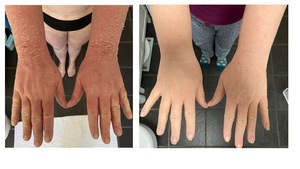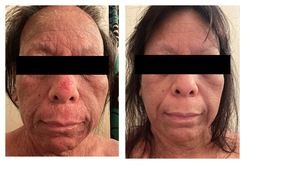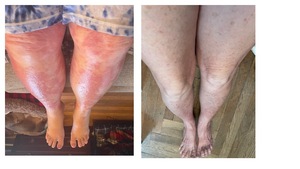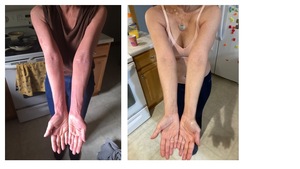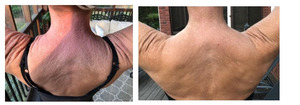Introduction
Topical corticosteroids (TCS) play a major role in the management of inflammatory skin diseases such as atopic dermatitis, allergic contact dermatitis, and psoriasis.1 While they are generally considered safe and effective, topical steroid withdrawal syndrome (TSW) can emerge after patients stop the use of topical steroids or even with concomitant use.2 Patients can present with burning, stinging, painful skin; oozing, purulent rashes; confluent or general redness sometimes in a “red sleeve” pattern on the arms or legs; profuse skin peeling and flaking; and/or thickened, loose skin with reduced elasticity.3,4 TSW patients often fail to improve even after restarting TCS. The reason for this remains unclear, highlighting the complex nature of this condition. Moreover, the morphology and distribution of the disease can deviate from the initial presentation, spreading to areas where TCS were never applied.5,6 Currently there is limited data on the incidence, risk factors, natural history, and therapeutic options for TSW. This study aims to add to the growing body of literature that establishes TSW as its own entity and highlights Traditional Chinese Medicine (TCM) as a treatment option.
Due to the largely unknown etiopathogenesis of TSW and its many overlapping features with severe AD, current treatment options for TSW are often limited to symptom management—restoring the skin barrier, calming inflammation without topical steroids, minimizing itch, and treating infection as needed.7,8 Tetracycline antibiotics, antihistamines, topical calcineurin inhibitors, ultraviolet therapy, and dupilumab have been reported as therapeutic modalities to treat TSW.2,9 Although TCM has not been extensively studied as a treatment for TSW, it has been practiced for thousands of years, including in the management of AD.10,11 Natural compounds commonly used in TCM have been widely studied for their anti-inflammatory effects, which can help alleviate AD by restoring the skin barrier, balancing Th1/Th2 cell levels, as well as regulating cytokine and chemokine expression.12 Furthermore, several randomized controlled trials (RCTs) have been published on the efficacy and safety of TCM in the treatment of AD.13 Study data showed that compared to placebo, herbal medicine improved the size and severity of skin lesions and sleep quality in patients with AD. Given the positive outcomes observed in AD patients, TCM presents a promising alternative treatment option for managing TSW.
TCM treatment of TSW differs from standard dermatologic care in that it focuses on treating the body as a whole, taking into account not only the visible symptoms but also the patient’s overall constitution, emotional and psychological symptoms, lifestyle, and underlying imbalances. From the TCM perspective, all diseases can be classified by their underlying patterns. Pattern identification, called “bian zheng” (辨證) in Chinese, takes into consideration designated layers of the human body that the condition has affected: from the superficial, external layer “Wei”(衛) to progressively deeper, internal layers “Qi” (氣) and “Ying”(營) ending with the deepest level where blood “Xue”(血) flows.14 Each layer affected informs the herbal ingredients to consider in order to remedy the problems at that respective level.15
In addition to the four levels, TCM also explores another phenomenon called Toxic Heat, in which internal heat builds because it is unable to escape that particular level. This roughly translates to a dysfunctional or damaged skin barrier. When the heat reaches a threshold, it interrupts other systems of the body. In the case of TSW, “heat” can be approximated to what we call “inflammation” in Western medical terminology.
TCM regards Toxic Heat as the central pattern of TSW. This pattern is described as a 1) widespread rapid evolution of deep red or purple lesions, 2) blanching lesions that can form thin diffuse white scales, 3) skin that is very hot to the touch despite patient complaints of chills and aversion to cold, 4) edema around the ankles and 5) restlessness, agitation, irritability, thrust, and lassitude particularly as the disease progresses.16,17 While patients with TSW can have varying degrees of Toxic Heat along with other patterns such as Damp Heat or Yin deficiency, the TCM treatment approach is unique because of its customizable nature.7,15 Damp Heat can roughly translate to purulent exudate and Yin Deficiency is characterized by dryness due to malabsorption or dysregulation of circulation or production of body fluids and blood. By understanding the different ratios of heat, damp heat, or yin deficiency that contribute to each patient’s presentation of TSW, TCM appropriately selects combinations of herbs that best suit each patient’s needs. Individualized treatment strategies and tailored herbal medicine regimens allow patients to experience relief in TSW symptoms with simultaneous improvement in other aspects of their health and wellbeing such as with sleep, agitation, and digestion.7
Methods
For this case series we chose 5 patients who completed individualized TCM treatment for TSW between June 2018 and May 2023 at a specialty clinic focused on treating dermatological conditions using herbal medicine. The diagnosis of TSW in this series was based on the clinical experience of the Traditional Chinese Medicine doctor, the patient’s dermatologist, as well as available literature. Currently, there are no standardized diagnostic criteria for TSW. In this case series, TSW was diagnosed by ruling out other conditions and identifying symptoms commonly described in the literature. These symptoms included worsening rash, widespread erythema beyond the original treatment area, and a lack of response to topical steroids. Patient charts and initial intake forms were reviewed, and the following variables were collected: age at diagnosis, initial diagnosis, length of TCS use, which TCS used, symptoms at initial presentation, symptoms throughout management of the condition, psychosocial impact, and patient outcomes after TCM treatment.
Each patient’s TCM formula was customized based upon presenting symptoms throughout the treatment process to match the evolving condition, including resolved, improved, unrelenting, and new symptoms. Changes to the formula included 1) changing ingredients, 2) dose adjustments of each ingredient, or even 3) changing the entire formula. Every formula took into consideration other issues the patient was experiencing. These inquiries included a series of questions in TCM called “The 10 questions” which evaluates temperature (hot, cold, fever, chills), sweat (spontaneous, time of day), digestion (taste, appetite, thirst), elimination, menstruation, sleep, pain, and location of issues. For dermatological concerns, the TCM formula considered different types of itch (nature, frequency, location, time of day when worse) as well as the amount of swelling and/or oozing. The answers to these questions served as clues to determine a pattern that the patient was presenting which then indicated a starting point for formula development. The solutions to each pattern were customized to match each patient and adjusted at every appointment thereafter, typically every 2-4 weeks depending on the severity and type of symptoms.
Effectiveness of TCM treatment was measured by decrease in the following acute symptoms: erythroderma, thermodysregulation, oozing, itch/pain, and sleep disturbances. These 5 symptoms were chosen as indicators of disease remission because they were often identified as being the most disruptive for patients with severe TSW. Furthermore, these symptoms are the most disparate from the more common eczema flares which helps distinguish TSW as its own entity. Through the TCM lens, when these more acute symptoms are eliminated or reduced, the clinician is better able to treat the more manageable remaining symptoms.
Case Series
Case 1 (Figure 1)
A 46-year-old female presented with severe forehead and perioral fissuring, oozing, and crusting along with general erythema on the neck, face, and extremities sparing the trunk. She was given an initial diagnosis of dyshidrotic eczema and nummular eczema at 44 years old and was prescribed clobetasol propionate for her hands and palms. After an initial 2-week course, the rashes returned and spread up both arms. Over the period of 9 months, the patient had 3 two-week courses of clobetasol propionate. She reported that symptoms only improved during active treatment and skin would worsen after she stopped treatment. The patient reported symptoms of red skin sleeves, dryness, tightness, flaking, extensive exfoliation that she referred to as “snowing,” swelling, fissures, and nerve pain at the start of experiencing TSW. The patient had been off TCS for 1 month before seeking TCM treatment. Initial acute symptoms were positive for erythroderma, thermodysregulation, oozing, itch/pain, and disturbed sleep. The patient received 13 months of herbal treatment. At the end of treatment, the patient demonstrated resolution of all five acute symptoms.
Case 2 (Figure 2)
A 54-year-old female presented with erythematous desquamated skin with patches of crusting on her face, hands, and shoulders. She was given an initial diagnosis of eczema at age 10. From ages 10-40, the patient applied hydrocortisone 1% twice daily on affected areas for a course of 2 weeks during flare ups that occurred approximately twice a year. At age 54, the patient developed a fungal rash that she treated with hydrocortisone 1% for 1 week before switching to an antifungal cream which she used for 3 weeks. One week later, the patient reported symptoms of TSW– red, burning skin that spread from the trunk to the neck and face. The symptoms progressed to a weeping rash with oozing along the hairline, ears, shoulders, nipples, and breasts. The patient had been off TCS for 5 months before seeking TCM treatment. Initial acute symptoms were positive for thermodysregulation, oozing, itch/pain, and sleep disturbances. The patient received 5 months of herbal treatment. At the end of treatment, the patient demonstrated resolution of thermodysregulation, oozing, and disturbed sleep; however, symptoms of itch and pain remained.
Case 3 (Figure 3)
A 71-year-old female presented with full body erythema, red sleeves, and oozing skin on her hands. She was diagnosed with eczema at age 12 and used hydrocortisone, betamethasone 0.05%, desonide 0.05% on small body irritations. At age 70, she started using triamcinolone 0.1% on her chest, arms, and legs. She was prescribed a course of prednisone 60 mg in December 2022 and then another course of prednisone 80 mg in January 2023. The patient then began to experience burning red skin and escalating itch. She reported sleep disturbances and night sweats. The patient reported stopping TCS for 1 year before seeking TCM treatment. Initial acute symptoms were positive for erythroderma, thermodysregulation, itch/pain, and sleep disturbances. The patient received 5 months of herbal treatment. At the end of treatment, the patient reported reduced severity of erythroderma, thermodysregulation, and itch/pain, and resolution of sleep disturbances.
Case 4 (Figure 4)
A 60-year-old female presented with full body erythema with areas of desquamation and oozing. She was diagnosed with eczema at age 7 and applied triamcinolone acetonide 0.1% nightly. She reported completing a course of prednisone for an eczema flare and a separate course of cephalexin for cellulitis. The patient reported symptoms of red skin, red sleeves, oozing, dryness, flaking, crusting, sleep disturbances, swelling, and skin infections at the start of TSW. The patient stopped TCS 1 year prior to starting TCM treatment. Initial acute symptoms were positive for erythroderma, thermodysregulation, oozing, itch/pain, and sleep disturbances. The patient received 3 months of herbal treatment. At the end of treatment, the patient reported resolution of thermodysregulation, oozing, and sleep disturbances. The patient reported ongoing itch/pain as well as residual erythroderma.
Case 5 (Figure 5)
A 45-year-old female presented with full body burning erythema with oozing and fissures. The patient had significant hair loss and reported symptoms of insomnia, mood swings, nerve pain, fatigue, and flu-like symptoms. She was diagnosed with eczema at the age of 12 and was treated with topical corticosteroids for 26 years at increasing potencies throughout the years. The patient began to develop allergies while on TCS and decided to wean off of TCS when she developed symptoms of TSW. The patient had stopped TCS use 6 years prior to TCM treatment. Initial acute symptoms were positive for erythroderma, oozing, itch/pain, and sleep disturbances. The patient received 4 months of herbal treatment. At the end of treatment, the patient reported resolution of erythroderma and sleep disturbances. The patient reported ongoing oozing of her skin as well as itch/pain.
Discussion
This case series illustrates different presentations of TSW among a subset of patients and showcases TCM as a treatment option for patients experiencing TSW. Our patient population is representative of previous studies of patients affected by TSW.2 In this case series, all patients were female, 3 of the 5 had a history of atopy, 4 of the 5 had an initial diagnosis of AD, and 3 of the 5 had over 12 months of TCS use. Cessation of TCS use in these patients led to all 5 patients developing diffusely red skin characteristic of TSW accompanied with burning skin. While additional symptoms such as elephant skin, oozing, and stinging paresthesias varied by case, each patient presented with symptoms unique to TSW and not easily explained by refractory AD.
In this case series, most patients sought out TCM treatment over 12 months after TCS cessation. All of these patients reported trying other treatments including calcineurin inhibitors, systemic steroids, emollients, and supplements before seeking out TCM treatment. At this point in their disease course, these patients had undergone workups for other dermatoses, had made unsuccessful attempts at treating suspected treatment-resistant AD, and arrived at TSW as a diagnosis of exclusion. In 2 of the patients, treatment with TCM led to complete response with resolution or reduced severity of all 5 acute symptoms. For the remaining 3 patients, TCM led to resolution of thermodysregulation and sleep disturbances; however, the patients experienced continued itch, pain, and erythema. Psychological surveying of the patients in this case series revealed serious impact on patients’ sex lives, ability to work, ability to exercise, and self-esteem. Three of the 5 patients reported persistent feelings of depression and anxiety. Patients also reported experiencing fear, poor memory, and difficulty concentrating due to TSW.
While the patients featured in this case series all reported noticeable improvements, we acknowledge that this series is limited by the absence of standardized severity scoring by a globally recognized measurement tool such as the Investigator Global Assessment (IGA).18 This was largely due to the fact that symptoms considered “acute” from the TCM perspective, such as thermodysregulation and sleep disturbances, are not captured in tools such as the IGA. We also acknowledge that significant obstacles to the adoption of TCM exist. These include concerns of potential toxicity, absence of uniform treatment protocols, limited high-quality trials and limited data on its mechanisms of action.19,20
In summary, TSW is a complex condition that can present differently among patients and have a significant impact on a patient’s quality of life. Most cases of TSW are self-diagnosed due to a lack of formal recognition and diagnostic criteria among dermatologists.21 Current treatment options for symptom management are limited and steroid-sparing biologics remain costly and can cause side effects.22,23 Traditional Chinese Medicine, and more specifically Chinese herbal medicine (CHM) may offer an alternative treatment option that could have few side effects for some patients.24 Due to its customizable approach, TCM and CHM can be continuously adjusted to meet individual needs. This case series aims to add to the growing evidence that TSW is a distinct entity that necessitates treatment options specific to its unique presentations. Traditional Chinese Medicine offers a non-steroidal option to alleviate the most severe TSW symptoms and seeks to address whole person health not limited to the skin.
Disclosures
PAL reports research grants/funding from AbbVie, AO Biome, National Eczema Association; is on the speaker’s bureau for AbbVie, Arcutis Eli Lilly, Galderma, Hyphens Pharma, Incyte, La Roche-Posay/L’Oréal, MyOR Diagnostics, Pfizer, Pierre-Fabre Dermatologie, Regeneron/Sanofi Genzyme; reports consulting/advisory boards for AbbVie, Almirall, Amyris, Arcutis, ASLAN, Boston Skin Science, Bristol-Myers Squibb, Burt’s Bees, Castle Biosciences, Codex Labs, Concerto Biosci, Dermavant, Dermira, DermVeda, Eli Lilly, Galderma, IntraDerm, Janssen, Johnson & Johnson, Kaleido Biosci, Kimberly Clark, LEO Pharma, Lipidor, L’Oréal, Menlo Therapeutics, Merck, Micreos, MyOR Diagnostics, Regeneron/Sanofi Genzyme, Sibel Health, Skinfix, Sonica, Theraplex, UCB, Unilever, Verrica, Yobee Care; stock options with Concerto Bioscie and Yobee Care. In addition, Dr. Lio has a patent pending for a Theraplex product with royalties paid and is a Board member and Scientific Advisory Committee Member Emeritus of the National Eczema Association.
OHF and CH report no conflict of interests.
